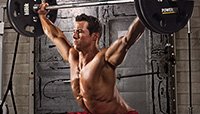Looking around gyms these days, I see plenty of smart trainees—the kind who know that when it comes to building strength and size, they can't beat the classic movements like deadlifts, squats, presses, pull-ups, and rows. These movements more than deserve their popularity, and their appeal is obvious: They recruit more muscles than any others, and they allow you to move the most weight.
But even in a solid program built around these staples, it's possible to leave something very important out. Look at that list of classic movements again: they're all most commonly performed bilaterally, meaning that you use two legs or two arms to move the weight.
Right about now is when a lot of other trainers will roll a BOSU ball out of the corner and start preaching to you about your imbalances while making you do something "functional" involving one leg and a pair of 5-pound dumbbells. That's not me. Without a doubt, there are plenty unilateral (single-limb) exercises you can do without. But the rear-leg elevated split squat (RLESS) isn't one of them.
I consider single-leg squats to be just as important as bilateral squatting to develop the legs, be it for strength, size, or just general conditioning and mobility. Call them "Bulgarian" or whatever else you want, but you need to find space in your program—and even more difficultly, in your gym—to perform the king of single-leg exercises.

Rear-Leg Elevated Split Squat
RAISE THE FOOT!
One obvious appeal of the RLESS, of course, is how much it trains balance and kinesthetic awareness. These are underrated skills in the weight room, especially if you are training for any type of athletic competition. Teaching the body to "multitask" by training strength and balance simultaneously improves overall neuromuscular coordination, which is also crucial if you have any aspirations of mastering advanced movements like the Olympic lifts.
You may not think of the RLESS as a heavy lift, but I can attest that it's also an effective way to build size and strength in the quads and glutes. It also activates important but hard-to-hit muscles like the VMO (vastus medialis oblique) and inner thighs. Along the way, the split stance helps develop muscular balance, because one leg can't compensate for the weaknesses of the other.
RLESS VS. OTHER SINGLE-LEG OPTIONS
Elevated split squats are superior to basic split squats because the trailing leg goes through a greater range of motion, which equates to more time under tension (TUT) and more simultaneous quad and glute activity. Why is this important? In my observation, flat split squats hit the quads especially hard and can lead to knee stress. The increased depth and subsequent glute activation of the RLESS help prevent that problem.
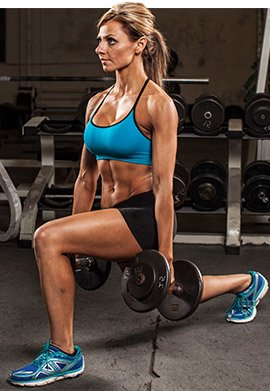
If your goal is improvement in a bilateral squat, the increased depth by RLESS makes it a superior assistance lift. In a basic split squat, the hip angle doesn't break parallel, because the trailing knee hits the floor first. With the rear foot elevated, the parallel plane can be met or broken, training the hips to mobilize enough to achieve deep squats elsewhere.
Lunges are great, as I've discussed previously , but I have to admit that I prefer the RLESS for building muscle. The reasons: They provide more time under tension and don't allow breaks between steps. I've also found that quadriceps tend to respond well to high TUT movements, even with relatively light weights.
Just think for a second about the quad development of elite athletes in sports which demand significant leg TUT, like skiing, cycling, and speed skating. That's your answer about whether or not types of training like this can produce serious growth—they're like the lower-body equivalent of male gymnasts. It's no coincidence that the RLESS is almost always a staple movement in their training programs.
RLESS Variations
Another advantage of the RLESS is that it offers multiple variations that offer benefits for lifters with different goals and levels of experience. Just as with lunges, adjusting the stride length and torso angle can change the game and allow you to prioritize one muscle over another. Here are the three most important variations:
Short Stride Length Quad Emphasis
If your knees can handle it—a big if—position your bottom foot relatively close to the elevated one, while still far enough that your heel stays firmly on the ground during the entirety of the lift. Allow your front knee to track over the toe, creating a deep ankle dorsiflexion. If you want to strictly develop the quads, this is the way to go. Still aim for a full ROM, which will be easier if the rear leg isn't elevated too high.
Regular stride length with angled torso Glute emphasis
The typical RLESS stance, where the front leg is far enough from the bench that the shin is vertical, gives a balanced stimulation of the quads and glutes. To further emphasize the posterior chain, simply lean forward slightly. It doesn't have to be drastic, but make sure your torso is angled a few inches forward as you descend. Dig in with the heel of the working leg and squeeze the glutes hard. Attempt to direct the trailing knee under the bench rather than simply toward the floor in front of it.
Regular stride length with vertical torso Hip mobility
To reiterate, just a couple inches in the RLESS make a big difference regarding which muscle group gets hit the hardest. Stay upright, get tall, and once again focus on directing the trailing knee under the bench. In this position, you create a weighted, dynamic hip flexor stretch that will improve mobility and flexibility. It has great carryover to squat depth while still building strength and balance. Now that's what I call an assistance exercise!
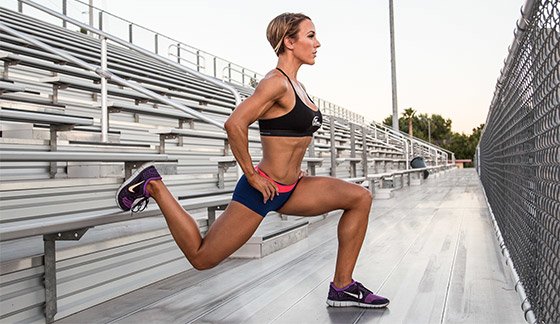
Back Foot Form Fixes
I see many lifters fumble and stumble while trying to create the best possible foot position to perform the RLESS. My initial fix for this issue is to have them position their elevated foot topside-down on the bench, which often helps them to reach maximum depth. People with ankle restrictions and mobility issues, however, often find this challenging and resort to performing the lift with the toes bent down instead—also known as the "squish the bug" method. This comes with its own downside, however; it places plenty of stress on the ligaments of the foot, which can lead to pain and problems under heavier loads.
Some gyms have a specific piece of equipment from Sorinex that allows the instep (top of the foot) to roll on a rounded, comfortable surface. This is a game-changer if you have access to one, but it's rare to find one of these bad boys in a typical gym. Unless the managers are really on their game, most won't see fit to include it in the budget.
A great alternative is to use the hamstring curl machine, which has a similar round surface to a split-squat bench. However, this machine is often located in an inconvenient place between rows of machines that doesn't allow sufficient space to squat. If you're on the hunt for a spot to squat, allow me to publicize my other simple fix for RLESS discomfort, using the back of an incline bench.
LEE BOYCE Fixing Your Rear-Leg Elevated Split Squat
Watch The Video - 3:56
Reap RLESS Results
Whether you're looking for more muscle, strength, performance, mobility, stability, or functionality, RLESS is a masterful movement to attack your goal. You need to be doing them, but more importantly, you need to be doing them right. Pick your variation, use a full range of motion, and enjoy the benefits of this fantastic exercise!
Recommended For You
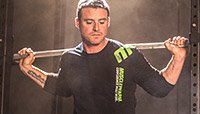
Leg Training: 8 Unique Quad Exercises
Here are eight unique, effective quad exercises that are sure to add serious size and shape to your legs.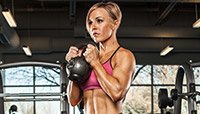
Grind To Grow: Try Your Squats And Presses With Kettlebells!
If you think the kettlebell's usefulness ends with the swing, you're missing out. Sub it out on squats and presses and build strength that shows!